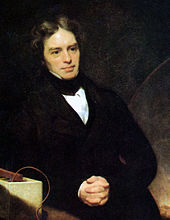Faraday's laws of electrolysis are quantitative relationships based on the electrochemical research published by Michael Faraday in 1833.[1][2][3]

First law
editMichael Faraday reported that the mass (m) of a substance deposited or liberated at an electrode is directly proportional to the charge (Q, for which the SI unit is the ampere-second or coulomb).[3]
Here, the constant of proportionality, Z, is called the electro-chemical equivalent (ECE) of the substance. Thus, the ECE can be defined as the mass of the substance deposited or liberated per unit charge.
Second law
editFaraday discovered that when the same amount of electric current is passed through different electrolytes connected in series, the masses of the substances deposited or liberated at the electrodes are directly proportional to their respective chemical equivalent/equivalent weight (E).[3] This turns out to be the molar mass (M) divided by the valence (v)
Derivation
editA monovalent ion requires one electron for discharge, a divalent ion requires two electrons for discharge and so on. Thus, if x electrons flow, atoms are discharged.
Thus, the mass m discharged is where
- NA is the Avogadro constant;
- Q = xe is the total charge, equal to the number of electrons (x) times the elementary charge e;
- F is the Faraday constant.
Mathematical form
editFaraday's laws can be summarized by
where M is the molar mass of the substance (usually given in SI units of grams per mole) and v is the valency of the ions .
For Faraday's first law, M, F, v are constants; thus, the larger the value of Q, the larger m will be.
For Faraday's second law, Q, F, v are constants; thus, the larger the value of (equivalent weight), the larger m will be.
In the simple case of constant-current electrolysis, Q = It, leading to
and then to
where:
- n is the amount of substance ("number of moles") liberated:
- t is the total time the constant current was applied.
For the case of an alloy whose constituents have different valencies, we have where wi represents the mass fraction of the ith element.
In the more complicated case of a variable electric current, the total charge Q is the electric current I(τ) integrated over time τ:
Here t is the total electrolysis time.[4]
Applications
edit- Electroplating – a process where a thin layer of metal is deposited onto the surface of an object using an electric current
- Electrochemical cells – generates electrical energy from chemical reactions
- Electrotyping – a process used to create metal copies of designs by depositing metal onto a mold using electroplating
- Electrowinning – a process that extract metals from their solutions using an electric current
- Electroforming – a process that deposits metal onto a mold or substrate to create metal parts
- Anodization – a process that coverts the surface of a metal into a durable corrosion-resistant oxide layer
- Conductive polymers – organic polymers that conduct electricity
- Water electrolysis – a process that uses an electric current to split water molecules into hydrogen and oxygen gases
- Electrolytic capacitors – a type of capacitor that uses an electrolytic solution as one of its plates
See also
editReferences
edit- ^ Faraday, Michael (1834). "on Electrical Decomposition". Philosophical Transactions of the Royal Society. 124: 77–122. doi:10.1098/rstl.1834.0008. S2CID 116224057.
- ^ Ehl, Rosemary Gene; Ihde, Aaron (1954). "Faraday's Electrochemical Laws and the Determination of Equivalent Weights". Journal of Chemical Education. 31 (May): 226–232. Bibcode:1954JChEd..31..226E. doi:10.1021/ed031p226.
- ^ a b c "Faraday's laws of electrolysis | chemistry". Encyclopedia Britannica. Retrieved 2020-09-01.
- ^ For a similar treatment, see Strong, F. C. (1961). "Faraday's Laws in One Equation". Journal of Chemical Education. 38 (2): 98. Bibcode:1961JChEd..38...98S. doi:10.1021/ed038p98.
Further reading
edit- Serway, Moses, and Moyer, Modern Physics, third edition (2005), principles of physics.
- Experiment with Faraday's laws